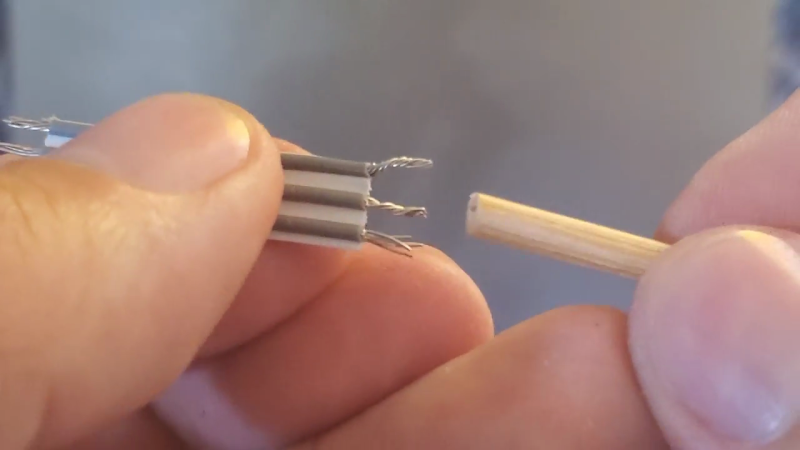Twisting stranded wire with your fingers in preparation for tinning and/or soldering is almost a reflex for folks making electronic assemblies. But what if the wires are too close to get your fingers around, or you have the fingers of a sumo wresters? Well [DIYDSP] has a solution for you (see video below the break) that’s easy to make from a shish kebab skewer that’s probably rolling around your kitchen drawer. The reason that [DIYDSP] wanted to twist such closely spaced wires was to solder a length of 0.1 in O.C. stranded ribbon cable directly onto a PCB pin header pattern.
The method is very simple. Drill a long hole in the factory-cut flat end, followed by using a countersink bit to give a conical taper to guide the wires in. [DIYDSP] found that a 1/16 inch (1.6 mm) drill bit was a bit too large to grip the types of wires he was using, and finally settled on a 0.6 mm bit. If you are using larger wires, you should experiment to get the right size, or just build a handful of these of differing diameters since they’re so easy to make — just mark them clearly so you don’t accidentally grill shish kebabs with them on the BBQ.
The resulting tool is not unlike the business end of a hand-held wire-wrap tool, but works different principle and is a fraction of the cost. If you do any amount of interconnect wiring with stranded wires, then you should check out this video and whip up a couple of these to throw in your tool box.
















phenomenal…!!!
That’s as effective as it is simple. And saves you the odd copper splinter when a stand comes lose whilst you twist it.
+1 for using a skewer instead of printing some complicated part.
Yeah, but he could have used a 555 ….
+1 555
556
Nice to see someone just making something out of stuff they had, instead of 3D printing it.
3D printing has its uses, and requires skills, but you do see a lot of “everything looks like a nail” uses of 3D printers.
Many 3D printers are used just to print future landfill material, so owners are happy to actually find them occasionally useful for practical purposes. That’s why you see so many 3D printed solutions. I use mine solely for tech hobby related items I engineer myself. I’m not interested in printing unicorns and such and would never have bought a 3D printer just for that.
Completely off topic, but the comment about sumo wrestlers’ fingers reminded me of a weird corner of YouTube I ended up in.
The man with the biggest (not actually diseased) hands: https://youtu.be/IichinALHkQ
in this case I usually strip the wires a bit longer than I want, simply rub them plainer and tin with solder. you will end up with V or Y shaped ends, but since you are a bit on the long side its simple to snip them off. As far as the example in the video, in that situation I would have paid a few cents for some mezzanine headers (basically long headers). Its not like they needed this in a pinch to get something working or test an object. If you’re going to polish a project, don’t use a turd.
Just dip the cut end of the ribbon cable in a solder pot. The heat will pull back the insulation leaving tinned leads.
Now you have melted plastic floating on the solder pot as they turn black and give off fumes.
Just be careful. It’s not that hard
Have you tried it? I have, or I wouldn’t have recommended it.
I always just use a pair of pliers – and you can do almost all the wires you would every want with just two sizes (medium and small) ones..
Get rid of this idea of twisting them with your fingers.
Doing so contaminates the join and can lend itself to cold joints.
Do yourself a favour an look at the NASA soldering course.
As a student i worked there one christmas 40:years ago, and had the pleasure of being trained to flight standard.
Soldered Electrical Connections NASA STD 8739.3
This course has been superseded by JSTD-001: Requirements for Soldered Electrical and Electronic Assemblies IPC
And apparantly it takes 5 days to learn it at a cost of $1351.00
You can still use most of the techniques and improve soldering, make it a habit.
I think the NASA videos are on line,, we got to solder and then look at it under a microscope
Agreed, there is no need to twist the wires. It just gets oils from your fingers into the joint. No good. Admittedly it can be difficult to get stranded wire through through holes.
When I strip the stranded wire, I don’t completely remove the insulation. I use that to twist the strands. Keeps it clean and saves my fingertips.